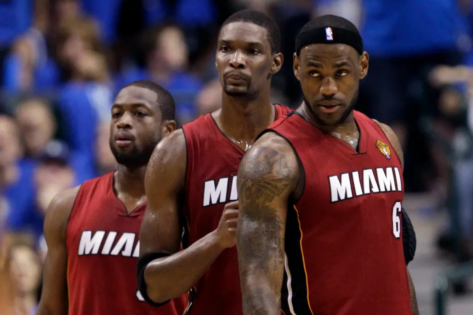They changed the game. When LeBron James, Dwyane Wade, and Chris Bosh teamed up in Miami, it wasn’t just a power move, it was a cultural shift. These weren’t just stars; they were alpha players in their prime, uniting with a singular goal: to win. Overnight, the Miami Heat became the most watched, loved, and hated team in basketball.
They reached four straight Finals and collected two rings along the way. The Big 3 era in Miami was marked by consistent success, including four Eastern Conference titles and Southeast Division championships each year they played together. The pressure was insane, and every loss felt like a collapse. Still, they made history and redefined the modern NBA superteam.
Amid the discussion about the Big 3, Paul Pierce recently weighed in on the Big 3’s formation on the @SpeakOnFS1 channel, implying that he inspired it. He said, “They were a younger version of us…It’s like when I started looking back….You know, we inspired all this for that era….From 2008 all the way to you know, when the Warriors picked up KD, and they formed the big 3.”
Paul Pierce asserts that the Celtics’ 2007 formation of a ‘Big 3’ with Kevin Garnett and Ray Allen not only transformed Boston but also ignited a new NBA era. Unlike the Celtics, who were formed via front-office trades, the Heat’s Big 3 were player-engineered, triggering a media firestorm. From ‘The Decision‘ to the ‘not one, not two, not three‘ parade moment, public opinion turned fast. To Paul Pierce, this was more than optics — it was proof that what Boston did came with more integrity. Pierce acknowledged that the success of the Celtics’ Big 3 directly influenced teams like the Miami Heat and Golden State Warriors to assemble their own superstar trios.
Mar 13, 2022; Boston, Massachusetts, USA; Basketball Hall of Fame and former Boston Celtic, Kevin Garnett embraces former Boston Celtics players, Ray Allan and Paul Pierce during the number retirement ceremony after the game between the Boston Celtics the Dallas Mavericks at TD Garden. Mandatory Credit: Gregory Fisher-Imagn Images
But for all their foundational influence, the Celtics’ Big 3 never dominated the decade like Miami’s did. Injuries and age caught up fast, and while Pierce sees them as pioneers, history remembers the Heat as the blueprint that actually worked.
Despite the Heat trio’s accolades, Rich Paul contends it wasn’t a true ‘Big 3’ since Chris Bosh assumed a secondary role. He said, “That wasn’t really a big 3…. but when you think about it, Bosh was the ultimate professional. He took a backseat, and he played a role in which because he had such a high IQ and he was such a professional as an individual. His approach to everything is what made that work.”
And understandably, many weren’t happy. And that makes sense. Ironically, Rich’s argument undercuts itself. By highlighting Bosh’s sacrifice and role fluidity, he unknowingly reinforces what defined Miami’s Big 3: three stars who knew how to win without ego.
For Rich, Bosh made the biggest personal sacrifice by adapting his game and accepting a less prominent role so the team could function better and win championships. This selflessness is what “made that work” for Miami.
How important was Chris Bosh to the Big 3?
Chris Bosh doesn’t get nearly enough credit for what he meant to the Miami Heat during the Big 3 era.
While LeBron was the do-it-all force and Wade brought the swagger and slashing buckets, Bosh was the one who quietly adapted, sacrificed, and held it all together. In Toronto, he was the guy, averaging over 24 a night. But in Miami? He took a step back on the stat sheet so the team could leap forward. His role shifted big time—he became a floor spacing big who could knock down midrange jumpers and later even threes, opening up the paint for LeBron and Wade to do their thing.
Defensively? Underrated as hell. Bosh was switching onto guards, contesting shots, grabbing key rebounds, and anchoring the Heat’s aggressive defensive schemes. He may have been the “third option,” but when it came to making winning plays, he showed up big. When LeBron and Wade struggled in Game 3 of the 2011 Eastern Conference Finals, Bosh erupted for 34 points on 13‑of‑18 shooting—a performance that swung momentum back to Miami with a 96–85 win
February 18, 2014: Miami Heat shooting guard Dwyane Wade #3, Miami Heat small forward LeBron James #6 and Miami Heat center Chris Bosh #1 observe the National Anthem before an NBA game between the Miami Heat and the Dallas Mavericks at the American Airlines Center in Dallas, TX Miami defeated Dallas 117-106 (Photo by Albert Pena/Icon SMI/Corbis/Icon Sportswire via Getty Images)
Bosh didn’t merely shrink his stat line; he transformed his skill set. In 2010–11, he attempted just 0.3 threes per game, shooting 24.0% from deep. By 2013–14, he was drilling 2.8 attempts at 33.9%, forcing defenses to guard the perimeter and opening the paint. That progression turned Miami’s small‑ball lineups into matchup nightmares.
Even with LeBron sidelined, Bosh owned the moment in Portland on December 28, 2013, drilling a 0.5‑second game‑winning three to lift the Heat to a 108–107 victory. His 37 points and 10 rebounds that night proved he could carry the load whenever Miami needed him.
Superteams win with talent, but they survive with sacrifice. Bosh didn’t just adjust — he evolved. And while Pierce may argue over titles, the Heat’s success proved that three alphas can work, so long as one plays the glue.
The post Amid Rich Paul Backlash, Celtics Legend Takes Credit for Inspiring Heat’s Big 3 Blueprint appeared first on EssentiallySports.
